安监总局40号令——重大危险源分级方法
- 格式:doc
- 大小:92.00 KB
- 文档页数:15
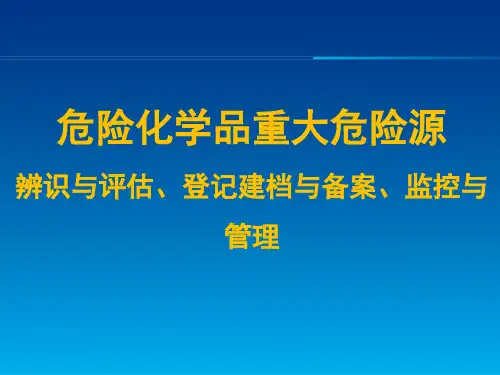
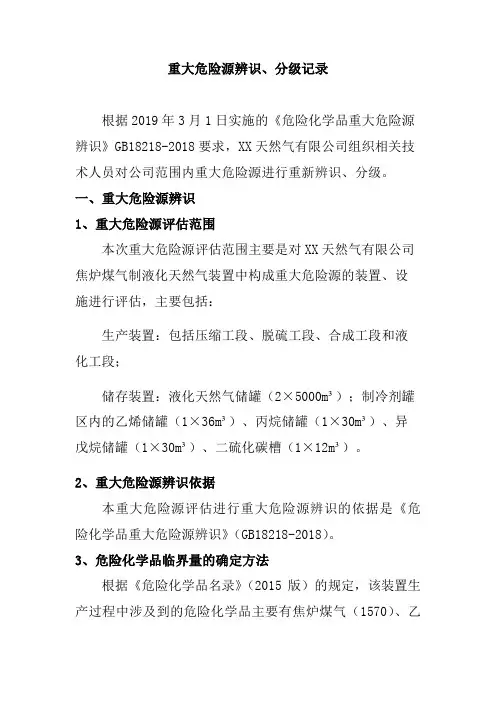
重大危险源辨识、分级记录根据2019年3月1日实施的《危险化学品重大危险源辨识》GB18218-2018要求,XX天然气有限公司组织相关技术人员对公司范围内重大危险源进行重新辨识、分级。
一、重大危险源辨识1、重大危险源评估范围本次重大危险源评估范围主要是对XX天然气有限公司焦炉煤气制液化天然气装置中构成重大危险源的装置、设施进行评估,主要包括:生产装置:包括压缩工段、脱硫工段、合成工段和液化工段;储存装置:液化天然气储罐(2×5000m³);制冷剂罐区内的乙烯储罐(1×36m³)、丙烷储罐(1×30m³)、异戊烷储罐(1×30m³)、二硫化碳槽(1×12m³)。
2、重大危险源辨识依据本重大危险源评估进行重大危险源辨识的依据是《危险化学品重大危险源辨识》(GB18218-2018)。
3、危险化学品临界量的确定方法根据《危险化学品名录》(2015版)的规定,该装置生产过程中涉及到的危险化学品主要有焦炉煤气(1570)、乙烯(2662)、丙烷(139)、异戊烷(1114)、二硫化碳(494)、液化天然气(2123)、氢气(1648)、氮(压缩或液化的,172)等。
根据《危险化学品重大危险源辨识》(GB18218-2018)的规定,该装置涉及的危险化学品被列入的有:焦炉煤气、液化天然气、乙烯、丙烷、异戊烷、二硫化碳、氢气。
根据《危险化学品重大危险源辨识》(GB18218-2018)的规定,该装置涉及的物质其临界量如下所示:表6.1-1 危险化学品名称及其临界量4、重大危险源的辨识标准根据《危险化学品重大危险源辨识》(GB18218-2018)的定义,危险化学品重大危险源是指长期地或临时地生产、加工、使用或储存危险化学品,且危险化学品的数量等于或超过临界量的单元。
生产单元:危险化学品的生产、加工及使用等的装置及设施,当装置及设施之间有切断阀时,以切断阀作为分隔界限划分为独立的单元。
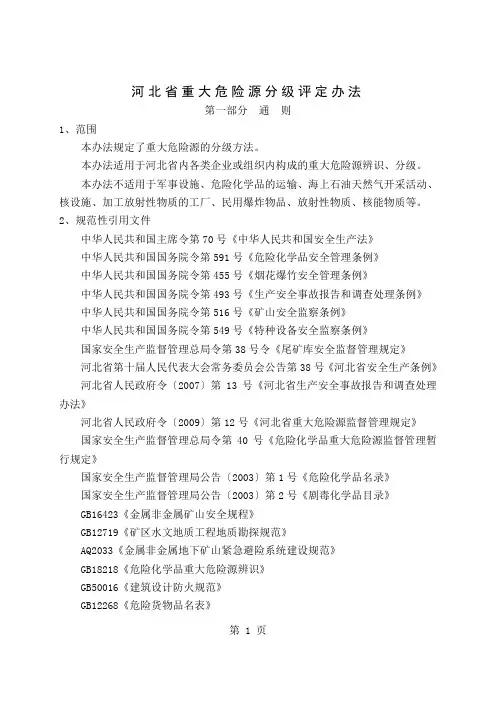
河北省重大危险源分级评定办法第一部分通则1、范围本办法规定了重大危险源的分级方法。
本办法适用于河北省内各类企业或组织内构成的重大危险源辨识、分级。
本办法不适用于军事设施、危险化学品的运输、海上石油天然气开采活动、核设施、加工放射性物质的工厂、民用爆炸物品、放射性物质、核能物质等。
2、规范性引用文件中华人民共和国主席令第70号《中华人民共和国安全生产法》中华人民共和国国务院令第591号《危险化学品安全管理条例》中华人民共和国国务院令第455号《烟花爆竹安全管理条例》中华人民共和国国务院令第493号《生产安全事故报告和调查处理条例》中华人民共和国国务院令第516号《矿山安全监察条例》中华人民共和国国务院令第549号《特种设备安全监察条例》国家安全生产监督管理总局令第38号令《尾矿库安全监督管理规定》河北省第十届人民代表大会常务委员会公告第38号《河北省安全生产条例》河北省人民政府令〔2007〕第13号《河北省生产安全事故报告和调查处理办法》河北省人民政府令〔2009〕第12号《河北省重大危险源监督管理规定》国家安全生产监督管理总局令第40号《危险化学品重大危险源监督管理暂行规定》国家安全生产监督管理局公告〔2003〕第1号《危险化学品名录》国家安全生产监督管理局公告〔2003〕第2号《剧毒化学品目录》GB16423《金属非金属矿山安全规程》GB12719《矿区水文地质工程地质勘探规范》AQ2033《金属非金属地下矿山紧急避险系统建设规范》GB18218《危险化学品重大危险源辨识》GB50016《建筑设计防火规范》GB12268《危险货物品名表》第 1 页GB50160《石油化工企业设计防火规范》GBZ230《职业性接触毒物危害程度分级》GB50028《城镇燃气设计规范》AQ2006《尾矿库安全技术规程》AQ8001《安全评价通则》TSGR0004《固定式压力容器安全技术监察规程》TSGD0001《压力管道安全技术监察规程-工业管道》HG20660《压力容器中化学介质毒性危害和爆炸危险程度分类》GB50161《烟花爆竹工程设计安全规范》GB20592《化学品分类、警示标签和警示性说明安全规范急性毒性》3术语和定义3.1重大危险源指长期地或者临时地生产、搬运、使用或者储存危险物品的数量及其他存在的危险能量等于或者超过临界量的单元(包括设施和场所)。
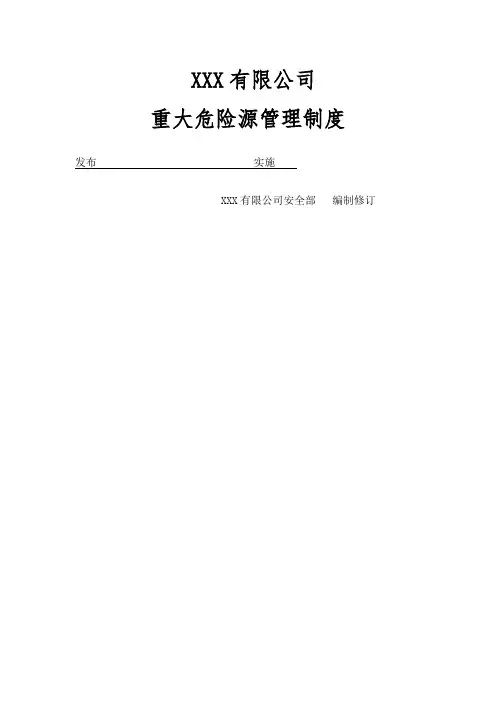
XXX有限公司重大危险源管理制度发布实施XXX有限公司安全部编制修订批准令本《XXX有限公司重大危险源管理制度》(以下简称《重大危险源管理制度》)是根据《中华人民共和国安全生产法》、《河北省安全生产条例》、《河北省关于落实生产经营单位安全生产主体责任暂行规定》、《危险化学品安全管理条例》、《危险化学品重大危险源监督管理暂行规定》、《河北省重大危险源监督管理规定》、《河北省重大危险源分级评定办法》、《河北省安全生产监督管理局关于进一步加强和规范全省重大危险源监管工作的通知》、《危险化学品重大危险源辨识》等法律法规和标准,并根据本公司实际情况编制,用于指导本公司的重大危险源管理活动。
本《重大危险源管理制度》已于2018年12月13日至12月20日经公司安全领导小组会议评审修订通过,现予批准并颁布实施,要求本公司的全体员工认真学习并执行。
本《重大危险源管理制度》自2018年12月20日起实施。
总经理(签字):年月日目录1.总则 (1)2.专人负责管理责任制 (2)3.辨识与评估管理制度 (4)辨识 (4)评估 (4)4.申报、备案与核销管理制度 (7)申报与备案 (7)变更与核销 (8)5.登记与建档管理制度 (8)6.警示标志与安全信息告知管理制度 (9)安全信息告知 (9)安全警示标志 (10)7.安全监控管理制度 (10)8.设备设施管理制度 (11)台账 (11)巡检 (11)检修与维保 (12)报废与拆除 (13)9.隐患排查治理制度 (14)10.安全教育培训管理制度 (16)11.应急管理制度 (18)应急物资 (18)应急培训 (18)应急演练 (18)12.安全操作规程 (19)装卸车 (19)巡检 (19)检修 (20)1.总则目的为加强对重大危险源的监督管理,有效防范危险化学品重特大安全生产事故的发生,特制定本制度。
编制依据《中华人民共和国安全生产法》(国家主席令13号)《危险化学品安全管理条例》(国务院令第591号)《危险化学品重大危险源监督管理暂行规定》(安监总局40号令)《河北省重大危险源监督管理规定》河北省人民政府令〔2009〕第12号《河北省重大危险源分级评定办法》(冀安监管应急〔2013〕93号)《河北省安全生产监督管理局关于进一步加强和规范全省重大危险源监管工作的通知》(冀安监管应急〔2017〕83号)《危险化学品重大危险源辨识》(GB18218-2018)范围本公司重大危险源管理。
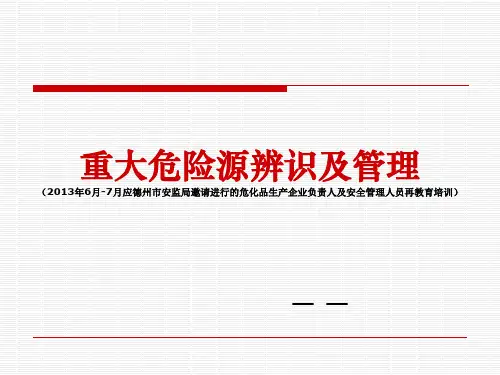
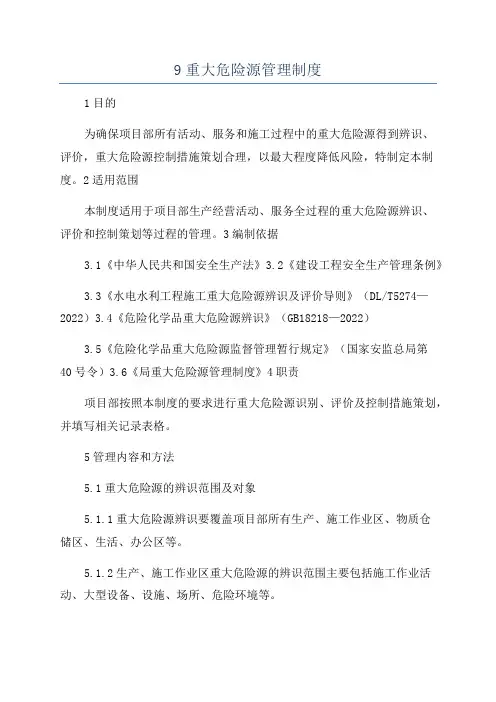
9重大危险源管理制度1目的为确保项目部所有活动、服务和施工过程中的重大危险源得到辨识、评价,重大危险源控制措施策划合理,以最大程度降低风险,特制定本制度。
2适用范围本制度适用于项目部生产经营活动、服务全过程的重大危险源辨识、评价和控制策划等过程的管理。
3编制依据3.1《中华人民共和国安全生产法》3.2《建设工程安全生产管理条例》3.3《水电水利工程施工重大危险源辨识及评价导则》(DL/T5274—2022)3.4《危险化学品重大危险源辨识》(GB18218—2022)3.5《危险化学品重大危险源监督管理暂行规定》(国家安监总局第40号令)3.6《局重大危险源管理制度》4职责项目部按照本制度的要求进行重大危险源识别、评价及控制措施策划,并填写相关记录表格。
5管理内容和方法5.1重大危险源的辨识范围及对象5.1.1重大危险源辨识要覆盖项目部所有生产、施工作业区、物质仓储区、生活、办公区等。
5.1.2生产、施工作业区重大危险源的辨识范围主要包括施工作业活动、大型设备、设施、场所、危险环境等。
5.1.2.1施工作业活动包括:明洞施工、洞挖施工、填筑工程、灌浆工程、混凝土浇筑、模板工程、金属结构制作、安装及机电设备安装、建筑物拆除等。
5.1.2.2大型设备包括:大型施工机械和大型起重运输设备。
5.1.2.3设施、场所包括:存弃渣场、供水系统、供风系统、供电系统、金属结构加工厂、道路桥梁隧洞等。
5.1.2.4危险环境包括:不良地质地段、潜在滑坡区、超标准洪水、粉尘、有毒、有害气体及有毒化学品泄漏环境等。
5.1.3物资仓储区重大危险源辨识的重点区域包括爆破器材库、油库油罐区、设备仓库、物资仓库等。
5.1.4生活、办公区重大危险源辨识的重点区域包括项目部职工生活区、食堂、其他公共聚集场所等。
5.2重大危险源辨识方法重大危险源评价按层次可分为总体评价、分部评价及专项评价。
按阶段可分为预评价和施工期评价。
5.3.1项目实施阶段,项目部在施工策划与准备阶段进行施工期重大危险源辨识和评价。
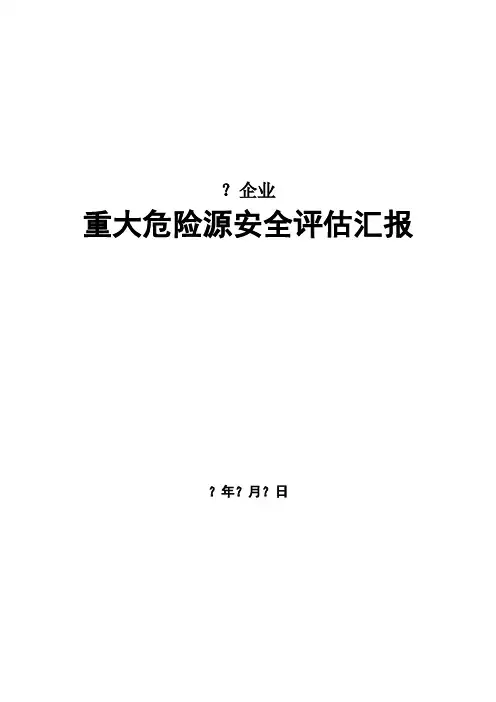
企业重大危险源安全评估汇报年月日评估人员目录一、评估旳重要根据二、重大危险源旳基本状况三、事故发生旳也许性及危害程度四、个人风险和社会风险值(仅合用定量风险评价措施)五、也许受事故影响旳周围场所、人员状况六、重大危险源辨识、分级旳符合性分析七、安全管理措施、安全技术和监控措施八、事故应急措施九、评估结论与提议编制阐明为认真贯彻“安全第一、防止为主、综合治理”旳安全生产方针,加强重大危险源旳管理,根据《安全生产法》第三十三条规定,“生产经营单位对重大危险源应当登记建档,进行定期检测、评估、监控,并制定应急预案,告知从业人员和有关人员在紧急状况下应当采用旳应急措施。
生产经营单位应当按照国家有关规定将本单位重大危险源及有关安全措施、应急措施报有关地方人民政府负责安全生产监督管理旳部门和有关部门立案。
”重大危险源安全评估是以辨识旳重大旳重大危险源为目旳旳安全评估过程,它是运用系统安全工程旳措施对重大危险源存在旳危险性进行定性和定量分析,得出该重大危险源发生危险旳也许性及其后果严重程度旳过程,是寻找用至少旳安全投资,最具有效旳控制重大危险源旳途径,使过程存在旳风险程度控制在可接受范围旳全过程。
为做好重大危险源安全评估工作,企业组织有关技术人员构成安全评估组,根据《危险化学品重大危险源辨识》(GB18218-2023),评估组认真对企业所辨识出旳重大危险源进行了全面旳研究,查阅了有关资料。
对现场进行了实地勘察、征询调研,对这些重大危险源在生产运行中也许存在旳危险、有害原因及其危害程度进行了全面旳识别与分析。
进行重大危险源等级划分。
在此基础上,根据评估需要,选择科学、合理旳评估模型对也许发生旳事故种类极其严重程度进行定性、定量评估。
对照有关规范和原则规定,提出防备事故旳安全对策措施和提议;最终得出评估结论。
在本次重大危险源安全评估工作中难免存在疏漏旳局限性之处,请予以指正。
评估组一、评估旳重要根据(一)根据(或参照)旳国家及行业有关法律、法规、规定1、《中华人民共和国安全生产法》(国家主席令第70号);2、《中华人民共和国消防法》(国家主席令第6号);3、《中华人民共和国职业病防治法》(国家主席令第60号);4、《中华人民共和国劳动法》(国家主席令第28号);5、《危险化学品安全管理条例》(国务院令第344号);6、《使用有毒物品作业场所劳动保护条例》(国务院令第352号);7、《安全生产许可证条例》(国务院令第397号);8、《特种设备安全监察条例》(国务院令第373号)、《国务院有关修改<特种设备安全监察条例>旳决定》(国务院令第549号);9、《国务院有关深入加强企业安全生产工作旳告知》(国发[2023]23号)。
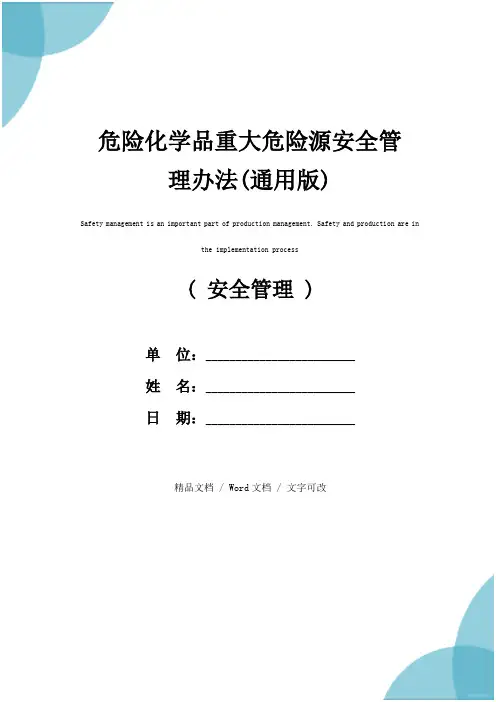
( 安全管理 )单位:_________________________姓名:_________________________日期:_________________________精品文档 / Word文档 / 文字可改危险化学品重大危险源安全管理办法(通用版)Safety management is an important part of production management. Safety and production are inthe implementation process危险化学品重大危险源安全管理办法(通用版)第一章总则第一条为贯彻“安全第一、预防为主、综合治理”方针,规范????(以下简称公司)危险化学品重大危险源(以下简称重大危险源)的安全管理,依据国家法律、规定和标准,结合公司实际,制定本办法。
第二条本办法规范了重大危险源的辨识、评估、建档、备案、日常管理、应急处置、检查评价等内容。
第三条本办法所称重大危险源是指按照《危险化学品重大危险源辨识》(GB18218)标准辨识确定,危险化学品的数量等于或者超过临界量的单元。
公司的重大危险源有储氨罐及氨区、制氢站及罐区、柴油罐及油区。
第四条关键名词术语解释(一)危险化学品:具有易燃、易爆、有毒、有害等特性,会对人员、设施、环境造成伤害或损害的化学品;(二)单元:一个(套)生产装置、设施或场所,或同属一个生产经营单位的且边缘距离小于500m的几个(套)生产装置、设施或场所;(三)临界量:对于某种或某类危险化学品规定的数量,若单元中的危险化学品数量等于或超过该数量,则该单元定为重大危险源;(四)重大危险源:长期地或临时地生产、加工、使用或储存危险化学品,且危险化学品的数量等于或超过临界量的单元。
第五条本标准适用于公司及各部门、各项目部(以下简称各部门)。
第六条引用文件(一)《安全生产法》(中华人民共和国主席令〔2014〕第13号);(二)《危险化学品重大危险源监督管理暂行规定》(国家安全生产监督管理总局〔2011〕第40号令);(三)《危险化学品重大危险源辨识》(GB18218-2014);(四)《电业安全工作规程(热力和机械部分)》(GB26164.1-2010);(五)《防止电力生产重大事故的二十五项重点要求》(国家能源局[2014]161号);(六)《燃煤发电厂液氨罐区安全管理规定》(国能安全〔2014〕328号)。
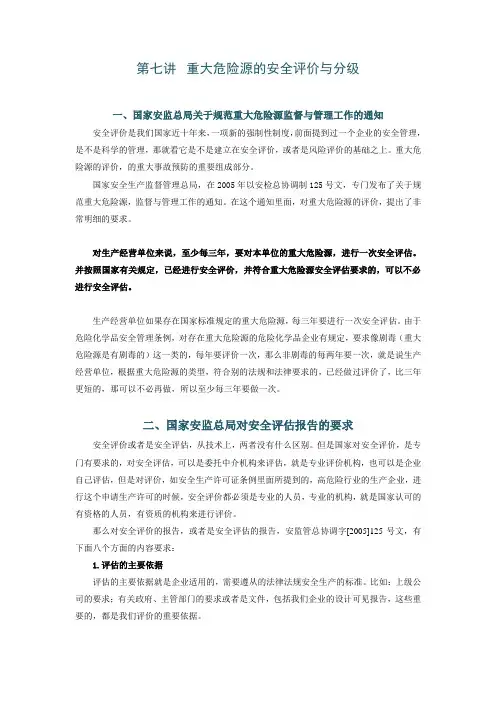
第七讲重大危险源的安全评价与分级一、国家安监总局关于规范重大危险源监督与管理工作的通知安全评价是我们国家近十年来,一项新的强制性制度,前面提到过一个企业的安全管理,是不是科学的管理,那就看它是不是建立在安全评价,或者是风险评价的基础之上。
重大危险源的评价,的重大事故预防的重要组成部分。
国家安全生产监督管理总局,在2005年以安检总协调制125号文,专门发布了关于规范重大危险源,监督与管理工作的通知。
在这个通知里面,对重大危险源的评价,提出了非常明细的要求。
对生产经营单位来说,至少每三年,要对本单位的重大危险源,进行一次安全评估。
并按照国家有关规定,已经进行安全评价,并符合重大危险源安全评估要求的,可以不必进行安全评估。
生产经营单位如果存在国家标准规定的重大危险源,每三年要进行一次安全评估。
由于危险化学品安全管理条例,对存在重大危险源的危险化学品企业有规定,要求像剧毒(重大危险源是有剧毒的)这一类的,每年要评价一次,那么非剧毒的每两年要一次,就是说生产经营单位,根据重大危险源的类型,符合别的法规和法律要求的,已经做过评价了,比三年更短的,那可以不必再做,所以至少每三年要做一次。
二、国家安监总局对安全评估报告的要求安全评价或者是安全评估,从技术上,两者没有什么区别。
但是国家对安全评价,是专门有要求的,对安全评估,可以是委托中介机构来评估,就是专业评价机构,也可以是企业自己评估,但是对评价,如安全生产许可证条例里面所提到的,高危险行业的生产企业,进行这个申请生产许可的时候,安全评价都必须是专业的人员,专业的机构,就是国家认可的有资格的人员,有资质的机构来进行评价。
那么对安全评价的报告,或者是安全评估的报告,安监管总协调字[2005]125号文,有下面八个方面的内容要求:1.评估的主要依据评估的主要依据就是企业适用的,需要遵从的法律法规安全生产的标准。
比如:上级公司的要求;有关政府、主管部门的要求或者是文件,包括我们企业的设计可见报告,这些重要的,都是我们评价的重要依据。
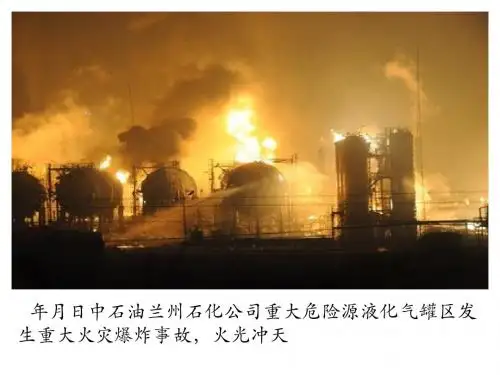

The State Administration of Work SafetyNo. 40 OrderThe Provisional Rules of Supervision and Management of Major hazardous Sources of Hazardous Chemicals, deliberated and passed by Director Office Meeting of the State Administration of Work Safety in July 22, 2011, is promulgated now and come into effect since Dec. 1, 2011Luo Lin, the State Administration of Work SafetyAug. 5, 2011 The Provisional Rules of Supervision and Management of Major Dangerous Sources of Hazardous ChemicalsChapter 1 General RulesArticle 1 To intensify the safety supervision and management of major dangerous sources of hazardous chemicals, to prevent and reduce the occurrence of accidents due to hazardous chemicals and to guarantee the life and property safety of the masses, this regulation is formulated according to related laws and administrative regulations of the Law of the PRC on safe Production and Regulations of Safety Management of Hazardous Chemical s.Article 2 Units that involve in the production, storage, use and operation of hazardous chemicals (hereinafter “hazardous chemicals units”) should apply this regulation in case of identification, assessment, registration and archiving, filing, verification and cancellation, and supervision and management of major dangerous sources of hazardous chemicals.This regulation is not applicable for the safety supervision and management of urban gas, major dangerous sources of hazardous chemicals used for defense research and production and that inside the port areas.Article 3 Major dangerous sources of hazardous chemicals specified in this regulation (hereinafter “major dangerous sources”) refers to the hazardous chemicals units (including sites and facilities) whose quantity is equal or exceeds the critical quantity in the process ofproduction, storage, use or handling, as identified according to the provisions of Identification of Major Dangerous Sources of Hazardous Chemicals (GB18218).Article 4 A hazardous chemicals unit is the subject of liability of safety management of major dangerous sources, and its principal should hold liabilities for the safety management of major dangerous sources, and ensure the required safety input for safe production of the major dangerous sources.Article 5 Safety supervision and management of major dangerous sources should apply the principle of combining jurisdictional supervision and administration by different levels.Safety supervision and management department of safety production under people’s government above county level should abide by related laws, regulations, standards and this regulation to carry out safety supervision and management of areas under the jurisdiction.Article 6 The State encourages the hazardous chemicals units to adopt appropriately advanced process, technology, equipment and automatic control system that will improve the security level of major dangerous sources, in order to propel the information construction of safety supervision and management department on major dangerous sources.Chapter 2 Identification and AssessmentArticle 7 The hazardous chemicals units should identify the major dangerous sources in the devices, facilities or sites for production, operation, storage and use of hazardous chemicals in the units according to the provisions of Identification of Major Dangerous Sources of Hazardous Chemicals, and record the identification process and results.Article 8 The hazardous chemicals units should assess the safety of the major dangerous sources and identify their security levels. The hazardous chemicals units may organize the certified safety engineers, technicians or invite experts to carry out safety assessment, or may also entrust safety assessment agencies of relevant qualifications to do that.For the hazardous chemicals units who should carry out safety assessment in accordance with the specification of the laws and administrative regulations, their safety assessment of major dangerous sources can be done with internal safety evaluation of the units where the safety evaluation report can be used for safety assessment report, or these units can also carry out safety assessment of major dangerous sources separately.By the dangerous degree of major dangerous source, they can be divided into four levels: level 1, level 2, level 3, and level 4. Level 1 is the highest level. The classification methods of major dangerous sources are listed in Attachment 1 of this regulation.Article 9 The hazardous chemicals units should entrust safety evaluation agencies of relevant qualifications to carry out safety assessment of major dangerous sources in order to identify the personal and social risk value, if the major dangerous sources fall into any of the following circumstances:(i) Being level 1 or level 2 major dangerous sources and the ratio of actual quantity of toxicgas (online) against the critical quantity specified in the Identification of Major Dangerous Sources of Hazardous Chemicals is equal to or bigger than 1;(ii) Being level 1 major dangerous sources and the ratio of actual quantity of explosives or liquefied flammable gas (online) against the critical quantity specified in the Identification of Major Dangerous Sources of Hazardous Chemicals is equal to or bigger than 1;Article 10 The safety evaluation report of major dangerous sources should be impartial and have accurate data, complete content, clear conclusion, and feasible measures, while including the following contents:(i) Main basis for assessment;(ii) Basic information of major dangerous sources;(iii) Possibility and dangerous degree of major dangerous sources;(iv) Personal risk and social risk value (only applicable for quantitative risk evaluation methods)(v) Surrounding sites or personnel that may be impacted by the accidents;(vi) Compliance analysis of identification and classification of major dangerous sources;(vii) Safety management measures, safety techniques and monitoring measures;(viii) Emergency measures for accidents; and(ix) Conclusion and recommendations of assessment.In case the dangerous chemicals units use the safety evaluation report to replace the safety assessment report, the content of the safety evaluation report related to major dangerous sources should comply with the requirements of Article 1 of this regulation.Article 11 The hazardous chemicals units should re-identify, re-evaluate and re-classify the major dangerous sources in case of any of the following circumstances:(i) The safety assessment of major dangerous source has been made for three years;(ii) Building, reconstruction and expansion of the devices, facilities or sites of major dangerous sources;(iii) Changes have taken place to the category, quantity, production and process or storage methods of the hazardous chemicals, as well as to the key equipment and facilities, which will affect the level of or risk degree of major dangerous sources;(iv) External production safety environment factor has changed and will affect the level of or risk degree of major dangerous sources;(v) Fatality or injuries of more than 10 persons in a hazardous chemicals related accident, which will affect the level of or risk degree of major dangerous sources;(vi) Changes are made to the national standards, industrial standard of identification or safety assessment of major dangerous sources.Chapter 3 Safety ManagementArticle 12 The hazardous chemicals units should establish complete safety management rules and regulations and safety operating instruction of major dangerous sources, and take effective measures to ensure it is fully implemented.Article 13 The hazardous chemicals units should build a complete safety supervision and monitoring system and establish complete control measures according to the category, quantity, production and process (method) of the hazardous chemicals, as well as to the key equipment and facilities:(i) The hazardous chemicals units should be equipped with uninterrupted acquisition andmonitoring system for measuring information of temperature, pressure, liquid level, flow,and composition, as well as with poisonous and harmful gas leak detection alarm devices, with information transmission, continuous recording, accident pre-warning, and information storage functions; the level 1 or level 2 major dangerous sources should have the emergency stops function. And the digital data recorded should be stored for no less than 30 days.(ii) The chemical production devices of the major dangerous sources should be provided with automatic control system that satisfies the safety production requirements; the level 1 or level 2 major dangerous sources should be furnished with emergency stop system.(iii) Emergency switching-off device should be set up in the key facilities for toxic gas, poisonous liquid and flammable gas in the major dangerous sources; leakage emergency treatment device should be set up for toxic gas facilities. The level 1 or level 2 major dangerous source involving toxic gas, liquefied gas and poisonous liquid should be provided with separated safety instrument system (SIS);(iv) Sites or facilities for storing poisonous materials in the major dangerous sources should be equipped with video monitoring system;(v) The safety monitoring system should comply with the provisions of national standards or industrial standards.Article 14 The personal or social risk value defined by quantitative risk evaluation in the major dangerous sources should not exceed the allowable threshold limits of personal and social risk value.If exceeding the allowable threshold limits of personal and social risk value, the hazardous chemicals units should take relevant measures to reduce risks.Article 15 The hazardous chemicals units should test and inspect the safety facilities and safety monitoring systems on a regular basis, and maintain and take care of the safety facilities and safety monitoring systems to ensure they work effectively and reliably. The maintenance, caring and inspection should be well recorded and signed by the responsible persons.Article 16 The hazardous chemicals units should clearly define the responsible person or agencies for the key devices and key parts of the major dangerous sources, and regularly inspect the safety production of the major dangerous sources, as well as take measures to eliminate theaccident threats. If the accident threats cannot be removed immediately, they should work out a treatment scheme timely, and implement the correction measures, responsibility, capital, time limit and emergency plan.Article 17 The hazardous chemicals units should carry out safety operation skill training for the operating personnel in terms of managing major dangerous sources, so as to enable them to learn the hazardous characteristics of the major dangerous sources, be familiar with the safety management rules and regulations and safety operating instruction of the major dangerous sources, and get hold of the safety operation skills and emergency measures of the post concerned.Article 18 The hazardous chemicals units should set up apparent safety warning signs and indicate the emergency response method in case of emergency in the sites of major dangerous sources.Article 19 The hazardous chemicals units should inform the potentially affected units, areas and persons in proper ways of the consequence and emergency measures of the possible accidents in the major dangerous sources.Article 20 The hazardous chemicals units should formulate an emergency plan for accidents in the major dangerous sources, establish emergency rescue organization and provide emergency rescue staff, furnish required protective equipment and emergency rescue device, equipment and material, and guarantee its proper and convenient use; coordinate with local people’s government safety production supervision and management department to work out an emergency plan for accidents of dangerous chemicals of the unit concerned.For the major dangerous source with inhaled poisonous and harmful gas, the hazardous chemicals units should provide portable concentration detection equipment, air respirator, chemical protective clothing, leak stopper and other emergency devices and equipment; if involving major dangerous sources with poisonous gas, more than two suits (including two suits) of airproof chemical protective clothing should be provided; if involving major dangerous sources with flammable or explosive gas or flammable liquid vapor, a certain number of portable flammable gas detection devices should be provided.Article 21 The hazardous chemicals units should work out an emergency plan for accidents of major dangerous sources, and carry out emergency drillings for accidents according to the following requirements:(i) Carry out specialized emergency response plan for major dangerous sources at least once ayear; and(ii) Carry out site disposal scheme for major dangerous sources at least once every six months.After the emergency drilling, the hazardous chemicals units should assess the effect of the emergency response plan, write an assessment report for the emergency drilling, analyze the potential problems, give revision suggestions, and improve it in a timely manner.Article 22 The hazardous chemicals units should register and file the identified major dangerous sources timely and item by item.The archive of major dangerous sources should include the following documents and materials:(i) Identification and classification record;(ii) Basic characteristics list of major dangerous sources;(iii) Safety and technical instructions involving all chemicals;(iv) Regional location plan, floor plan, process flow diagram and main equipment list;(v) Safety management rules and regulations as well as safety operating instructions of major dangerous sources;(vi) Safety monitory and control system, measure instruction, testing and inspection results;(vii) Emergency plan, review comments, drill plan and assessment report of major dangerous sources;(viii) Safety assessment report or safety evaluation report;(ix) Names of the principal and responsible agency of the key devices, key parts of major dangerous sources;(x) Setting of safety warning signs in the site of major dangerous sources; and(xi) Other document and materials.Article 23 The hazardous chemicals units should complete the filing application form of major dangerous source within 15 days after finishing the safety assessment report or safety evaluation report of major dangerous sources, and submit with the archiving materials (for the documents stated in item 5 of clause 2, only the list is required) of major dangerous sources specified in Article 22 to the safety supervision and management department of safety production under people’s government of county level for filing.The safety supervision and management department of safety production under people’s government of county level should send the filing materials of level 1 and level 2 major dangerous sources to the safety supervision and management department of safety production under municipal people’s government quarterly. And the municipal people’s government should send the filing materials of level 1 major dangerous sources to the supervision and management department of safety production under provincial people’s government every six months.In case of any of the circumstances stated in Article 21 of this regulation, the hazardous chemicals units should update the archive timely and re-file it with the local supervision and management department of safety production under people’s government at the county level.Article 24 The hazardous chemicals units should accomplish the identification, safety assessment and classification, registration and archiving of major dangerous sources prior to the acceptance of completion of the construction project, and file with the local supervision and management department of safety production under people’s government at the county level.Chapter 4 Supervision and ReviewArticle 25 Local supervision and management department of safety production under people’s government at the county level should establish complete management system for major dangerous sources of hazardous chemicals, clarify the responsible persons and intensify file archiving.Article 26 Local supervision and management department of safety production under people’s government at the county level should summarize and send the filing materials of major dangerous sources within the jurisdiction in the previous year to the supervision andmanagement department of safety production under municipal people’s government before January 15 every year. The municipal people’s government should summarize and send the filing materials of major dangerous sources within the jurisdiction in the previous year to the supervision and management department of safety production under provincial people’s government before January 31 every year. And the provincial people’s government should summarize and send the filing materials of major dangerous sources within the jurisdiction in the previous year to the State Administration of Work Safety before February 15 every year.Article 27 If the major dangerous sources are proved to be major dangerous source after safety evaluation or safety assessment, the hazardous chemicals units should apply for cancellation to the local supervision and management department of safety production under people’s government at the county level.In case of applying for cancellation of major dangerous sources, the following documents and materials should be submitted:(i) Application form with the specification of cancellation reason;(ii) Company name, legal representative, venue, contact person and contact information; and(iii) Safety evaluation report and safety assessment report.Article 28 Local supervision and management department of safety production under people’s government at the county level should verify the documents and materials applied for cancellation within 30 days after receiving them. These documents and materials, if conforming to the conditions, will be canceled and an evidence document will be provided; if not, a statement will be notified to the application unit in written form. If necessary, local supervision and ma nagement department of safety production under people’s government at the county level may invite experts to carry out on-site inspection.Article 29 Local supervision and management department of safety production under people’s government at the country level should send the filing materials of level 1 and level 2 major dangerous sources for cancellation within the jurisdiction to the supervision and management department of safety production under municipal people’s government quarterly. The municipal pe ople’s government should send the filing materials of level 1 major dangerous sources forcancellation within the jurisdiction to the supervision and management department of safety production under provincial people’s government every six months.Article 30 Local supervision and management department of safety production under people’s government above county level should strengthen the supervision and inspection of hazardous chemicals units in major dangerous sources, and urge them to carry out the identification, safety evaluation and classification, registration and archiving, filing, supervision and monitoring, formulation of emergency plan for accidents, cancellation and safety management of hazardous chemicals units.In case the major dangerous sources are supervised and inspected for the first time, the following contents should be included:(i) Operation of major dangerous sources, formulation and implementation of safetymanagement rules and regulations and safety operating instruction;(ii) Identification, classification, safety assessment, registration and archiving, and filing of major dangerous sources;(iii) Monitoring and control of major dangerous sources;(iv) Testing, inspection and maintenance of safety facilities and safety monitoring system of major dangerous sources;(v) Formulation, review, filing, revision and drilling of emergency plan for accidents of major dangerous sources;(vi) Safety training and education of practitioners;(vii) Setting of safety signs;(viii) Provision of devices, equipment and materials for emergence rescue; and(ix) Implementation of accident prevention and control countermeasures.The supervision and management department of safety production, should order the units concerned to remove, if finding any accident threats in the major dangerous sources in the process of supervision and inspection; should order the operating personnel to move out andorder to suspend production or operation or using, if the major accident threats have no guarantee of being safe before or in the process of removing. After the removing of major accident threats, the units concerned can recover production, operation and using only after being reviewed and approved by the supervision and management department of safety production.Article 31 The supervision and management department of safety production of local people’s government of at or above the county level should join with relevant department of same level under people’s government to strengthen the supervision and inspec tion of major dangerous sources concentration area such as industry (chemical industry) parks, and ensure that the major dangerous sources keep a safe distance with the key targets and sensitive venues such as surrounding units, residential quarters and crowd places.Chapter 5 Legal LiabilityArticle 32 The hazardous chemicals units should be ordered by the supervision and management department of safety production of local people’s government at or above the county level to make corrections within a time limit in case of any of the following circumstances; should be ordered to suspend production or operation and fined a sum of between 20,000-100,000 yuan, if the correction is not made afterwards.(i) Safety assessment or safety evaluation is not made to the major dangerous sourcesaccording to this regulation;(ii) Registration and archiving is not done to the major dangerous sources according to this regulation;(iii) Safety monitoring and control is not done to the major dangerous sources according to this regulation and related standards; and(iii) Emergency plan for accidents of the major dangerous sources are not worked out.Article 33 The hazardous chemicals units should be ordered by the supervision and management department of safety production of local people’s government at or above the county level to make corrections within a time limit in case of any of the following circumstances; should be ordered to suspend production or operation and fined a sum of between 50,000 yuan, if the correction is not made afterwards.(i) Safety warning signs are not clearly set up in the potential major dangerous sources; and(ii) Testing and inspection are not made regularly to the equipment and facilities of the major dangerous sources.Article 34 The hazardous chemicals units should be warned by the supervision and management department of safety production of local people’s government at or above the county level and fined a sum of 5,000-30,000 yuan in case of any of the following circumstances:(i) Identification is not made to the major dangerous sources according to this regulation;(ii) The responsible person and agencies for the key devices and key parts of the major dangerous sources are not defined according to this regulation;(iii) The emergency rescue organization is not established or emergency rescue staff, required protective equipment and emergency rescue device, equipment and material are not provided and guaranteed to be intact;(iv) Filing and cancellation of major dangerous sources are not made according to this regulation;(v) Information of the consequence and emergency measures of the possible accidents in the major dangerous sources is not informed to the potentially affected units, areas and persons;(vi) Drill of emergency plan of accidents in the major dangerous sources are not carried out according to this regulation; and(vii) Inspection is not made regularly to the safety production in the major dangerous sources and measures are not taken properly to eliminate accident threats according to this regulation.Article 35 Organizations who undertake the testing, inspection and safety assessment, should be prosecuted for criminal liability according to relevant laws, if providing false proofs and constituting a crime; have their illegal gains confiscated by the supervision and management department of safety production of local people’s government at or above the county level, if being not serious enough for criminal punishment; be fined a sum of between twice and five times of the illegal gains, which if exceeding 50,000 yuan; be fined, additionally or exclusively,a sum of between 5,000 and 20,000 yuan, if the illegal gains is less than 5,000 yuan; meanwhile, the principal who is directly in charge and other persons who are directly in charge can be fined a sum of 5,000 and 50,000 yuan; and if damages are caused to other people, the hazardous chemical units should bear joint and several liability.Any organization that has committed any of the illegal acts as mentioned in the preceding paragraph shall be disqualified accordingly.Chapter 6 AttachmentArticle 36 This regulation shall come into effect on Dec. 1, 2011.Attachment:1. Classification methods for major dnagerous sources of hazardous chemicals2. Allowable risk stadanrds。
1.重大危险源评估概述1.1 安全评估目的贯彻执行《中华人民共和国安全生产法》、《危险化学品管理条例》等法律法规的规定,重大危险源需定期进行安全评估的要求。
依据相关标准、规定,全面掌握和分析重大危险源的基本状况,判别危险等级,为推进重大危险源登记,完善数据库建设工作,提供翔实依据。
通过对重大危险源安全现状评估,判别和确认重大危险源安全现状与法律法规、标准等的差距,提出安全技术和安全管理的整改建议,为安全生产监督部门督促整改,依法整治和监管提出依据,以实现消除隐患,确保安全生产。
1.2 安全评估依据1.2.1 法律、法规和部门规章、标准、规范(1)《中华人民共和国安全生产法》(主席令2014版);(2)《中华人民共和国劳动法》(主席令第28号);(3)《中华人民共和国消防法》(主席令第6号);(4)《中华人民共和国环境保护法》(主席令第22号);(5)《中华人民共和国职业病防治法》(主席令第52号)。
(6)《危险化学品安全管理条例》(国务院令第591号);(7)《工伤保险条例》(国务院令第586号);(8)《监控化学品管理条例》(国务院令第190号);(9)《易制毒化学品管理条例》(国务院令第445号)。
(10)《危险化学品重大危险源监督管理暂行规定》(安监总局40号令);(11)《生产经营单位安全培训规定》(安监总局第3号令);(12)《劳动防护用品监督管理规定》(国家安监总局令第1号,2005年);(13)《危险化学品名录》(国家安全生产监督管理局,2015);(14)《剧毒化学品目录》(2015年版)(国家安全生产监督管理局,2003第2号);(15)《山东省安全生产监督管理规定》(山东省人民政府141号令);(16)《关于严格执行化工企业安全生产禁令的通知》(鲁安监[2007]115号);(17)《山东省安全生产条例》(山东省人大常委会公告第80号);1.2.2 标准规范(1)《建筑设计防火规范》(GB50016-2006);(2)《储罐区防火堤设计规范》(GB50351-2005);(3)《工业企业设计卫生标准》(GBZ1-2010);(4)《工业企业总平面设计规范》(GB50187-2012);(6)《建筑抗震设计规范》(GB50011-2001);(7)《建筑物防雷设计规范》(GB50057-2010);(8)《爆炸和火灾危险环境电力装置设计规范》(GB50058-1992);(9)《危险化学品重大危险源辨识》(GB18218-2009);(10)《建筑灭火器配置设计规范》(GB50140-2005);(11)《安全标志》(GB2894-2008);(17)《安全色》(GB2893-2008);(18)《低压配电设计规范》(GB50054-2009);1.2.3 有关文件和技术资料1)企业法人营业执照;2)安全生产许可证;3)东营市金诺精细化工有限责任公司的其他技术资料、图纸等和安全管理制度、应急救援预案等;1.3 安全评估范围和内容1.3.1 安全评估范围本项目评估范围为东营市金诺精细化工有限责任公司构成重大危险源的储罐区。
河北省重大危险源分级评定办法(冀安监管应急〔2013〕93号)第一部分通则1、范围本办法规定了重大危险源的分级方法。
本办法适用于河北省内各类企业或组织内构成的重大危险源辨识、分级。
本办法不适用于军事设施、危险化学品的运输、海上石油天然气开采活动、核设施、加工放射性物质的工厂、民用爆炸物品、放射性物质、核能物质等。
2、规范性引用文件中华人民共和国主席令第70号《中华人民共和国安全生产法》中华人民共和国国务院令第591号《危险化学品安全管理条例》中华人民共和国国务院令第455号《烟花爆竹安全管理条例》中华人民共和国国务院令第493号《生产安全事故报告和调查处理条例》中华人民共和国国务院令第516号《矿山安全监察条例》中华人民共和国国务院令第549号《特种设备安全监察条例》国家安全生产监督管理总局令第38号令《尾矿库安全监督管理规定》河北省第十届人民代表大会常务委员会公告第38号《河北省安全生产条例》河北省人民政府令〔2007〕第13号《河北省生产安全事故报告和调查处理办法》河北省人民政府令〔2009〕第12号《河北省重大危险源监督管理规定》国家安全生产监督管理总局令第40号《危险化学品重大危险源监督管理暂行规定》国家安全生产监督管理局公告〔2003〕第1号《危险化学品名录》国家安全生产监督管理局公告〔2003〕第2号《剧毒化学品目录》GB16423《金属非金属矿山安全规程》GB12719《矿区水文地质工程地质勘探规范》AQ2033《金属非金属地下矿山紧急避险系统建设规范》GB18218《危险化学品重大危险源辨识》GB50016《建筑设计防火规范》GB12268《危险货物品名表》GB50160《石油化工企业设计防火规范》GBZ230《职业性接触毒物危害程度分级》GB50028《城镇燃气设计规范》AQ2006《尾矿库安全技术规程》AQ8001《安全评价通则》TSGR0004《固定式压力容器安全技术监察规程》TSGD0001《压力管道安全技术监察规程-工业管道》HG20660《压力容器中化学介质毒性危害和爆炸危险程度分类》GB50161《烟花爆竹工程设计安全规范》GB20592《化学品分类、警示标签和警示性说明安全规范急性毒性》3术语和定义3.1重大危险源指长期地或者临时地生产、搬运、使用或者储存危险物品的数量及其他存在的危险能量等于或者超过临界量的单元(包括设施和场所)。
关于国家安全生产监督管理总局公告2014年第13号《危险化学品生产、储存装置个人可接受风险标准和社会可接受风险标准(试行)》中的“我国个人可接受风险标准值表”与国家安全生产监督管理总局令第40号《危险化学品重大危险源监督管理暂时规定》附件2可容许风险标准中的“表1可容许个人风险标准”在安全评价执行过程中存在的有关疑惑在国家安全生产监督管理总局2014年第13号公告《危险化学品生产、储存装置个人可接受风险标准和社会可接受风险标准(试行)》解读中明确指出:“本次将定量风险评价应用于外部安全防护距离的确定,是在《化工企业定量风险评价导则》(AQ/T 3046-2013)公布以后,对国家安全生产监督管理总局40号令第九条有关规定的扩展延伸”,那么在《危险化学品生产、储存装置个人可接受风险标准和社会可接受风险标准(试行)》中规定的我国个人可接受风险标准值表(以下简称个人可接受风险标准)规定的“防护目标”是否可以认为是对安监总局40号令附件2《可容许风险标准》中“表1可容许个人风险标准中”(以下简称可容许个人风险标准)“危险化学品单位周边重要目标和敏感场所类别”的补充和延伸解释?由于二者存在不一致之处,在具体的安全评价(评估)执行过程中有关评价单位之间包括评审专家在内存在诸多分歧,影响到标准的宣贯执行,为便于理解,首先列出上述两个标准对比如下:我国个人可接受风险标准值表(安监总局2014年第13号公告 2014年5月7日)可容许个人风险标准(安监总局令第40号附件2可容许风险标准,2011年12月1日起施行)从上表可以看出,二者在外部防护对象定义(分别为防护目标与危险化学品单位周边重要目标和敏感场所类别举例)及标准等级与数值上(如三级风险与二级风险、人口数量确定等)有诸多不同之处,执行中存在疑惑,具体表现为:1、《个人可接受风险标准》对于新建装置人员个体容许死亡概率≤3×10-7中规定的“高敏感场所”举例比《可容许个人风险标准》增加了“监狱”,该增加项是否适用于《可容许个人风险标准》中个体容许死亡概率<3×10-7中关于“高敏感场所”的举例规定?《个人可接受风险标准》“重要目标”举例增加了“军事禁区”,没有“党政机关”,请问:“党政机关”是否适用于《个人可接受风险标准》,军事禁区是否适用于《可容许个人风险标准》?在《个人可接受风险标准》中“特殊高密度场所”规定(人数≥100人)而且举例除“大型体育场、大型交通枢纽”外,另外增加了“露天市场、居民区、宾馆、度假村、办公场所、商场、饭店、娱乐场所”,请问:(人数≥100人)之规定以及举例中的几个增加项是否适用于《可容许个人风险标准》,如果不适用,在40号令执行时人数规模有无其它参考规定?2、在《个人可接受风险标准》中对于新建装置人员个体容许死亡(概率≤3×10-6)规定的“居住类高密度场所”和“公众聚集类高密度场所”列举的内容与《可容许个人风险标准》中关于人员个体容许死亡概率<1×10-6中规定的“居住类高密度场所”和“公众聚集类高密度场所”完全一致,但是《个人可接受风险标准》中规定了人口规模(30人≤人数<100人),请问该人数规定是否适用《可容许个人风险标准》,还是另有人数规模规定?3、《危险化学品生产、储存装置个人可接受风险标准和社会可接受风险标准(试行)》解读中指出“与40号令第九条规定相比,采用定量风险评价法确定外部安全防护距离的装置范围更广,依据的个人可接受风险标准更适用于危险性稍低于40号令第九条所列的装置。
重大危险源评估和安全管理制度1目的为了加强重大危险源的管理,防止重大安全事故的发生,降低事故造成的损失,特制定本制度。
2范围本制度适用于公司生产范围内,按照《重大危险源辩识》(GB18218—2018)《危险化学品重大危险源监督管理暂行规定》(安监总局第40号令)识别出的所有重大危险源的管理。
3主体及职责范围3.1总经理对公司重大危险源安全管理全面负责。
3.1.1组织建立重大危险源安全包保责任制并指定对重大危险源负有安全包保责任的技术负责人、操作负责人;3.1.2组织制定重大危险源安全生产规章制度和操作规程,并采取有效措施保证其得到执行;3.1.3组织对重大危险源的管理和操作岗位人员进行安全技能培训;3.1.4保证重大危险源安全生产所必需的安全投入;3.1.5督促、检查重大危险源安全生产工作;3.1.6组织制定并实施重大危险源生产安全事故应急救援预案;3.1.7组织通过危险化学品登记信息管理系统填报重大危险源有关信息,保证重大危险源安全监测监控有关数据接入危险化学品安全生产风险监测预警系统。
3.2 技术负责人对公司分管范围内重大危险源安全管理具体负责。
3.2.1组织实施重大危险源安全监测监控体系建设,完善控制措施,保证安全监测监控系统符合国家标准或者行业标准的规定;3.2.2组织定期对安全设施和监测监控系统进行检测、检验,并进行经常性维护、保养,保证有效、可靠运行;3.2.3对于超过个人和社会可容许风险值限值标准的重大危险源,组织采取相应的降低风险措施,直至风险满足可容许风险标准要求;3.2.4组织审查涉及重大危险源的外来施工单位及人员的相关资质、安全管理等情况,审查涉及重大危险源的变更管理;3.2.4每季度至少组织对重大危险源进行一次针对性安全风险隐患排查,重大活动、重点时段和节假日前必须进行重大危险源安全风险隐患排查,制定管控措施和治理方案并监督落实;3.2.5组织演练重大危险源专项应急预案和现场处置方案。
危险化学品安全“两重点一重大”之重大危险源《危险化学品从业单位安全生产标准化评审标准》(安监总管三〔2011〕93号、浙安监管危化〔2011〕204号,以下简称《评审标准》)对危险化学品重大危险源管理提出了不同的安全管理措施、技术措施及设施等特殊要求,综合学习分析近来发布的规章与文件精神,对安全管理措施、技术措施及设施有规定的文件主要包括国家安全监管总局40号令、41号令,安监总管三〔2010〕186号等。
下面将相关条款予以提炼解读,供有需要的朋友学习。
1.《关于危险化学品企业贯彻落实《国务院关于进一步加强企业安全生产工作的通知》的实施意见》(安监总管三〔2010〕186号)文件第2、13、24、25、34、37条对重大危险源管理做了规定,其中第13条规定需要注意。
要保证重大危险源安全管理与监控所必需的资金投入,定期检查维护,对存在事故隐患和缺陷的,要立即整改;重大危险源涉及的压力、温度、液位、泄漏报警等重要参数的测量要有远传和连续记录,液化气体、剧毒液体等重点储罐要设置紧急切断装装置。
要按照有关规定配备足够的消防、气防设施和器材,建立稳定可靠的消防系统,设置必要的视频监控系统,但不能以视频监控代替压力、温度、液位、泄漏报警等自动监控措施。
2.《危险化学品生产企业安全生产许可证实施办法》(国家安全生产监督管理总局令第41号)41号令第8、11、14、21、25条对重大危险源管理做了规定,其中第21条规定需要注意。
企业应当符合下列应急管理要求:生产、储存和使用氯气、氨气、光气、硫化氢等吸入性有毒有害气体的企业,除符合本条第一款的规定外,还应当配备至少两套以上全封闭防化服;构成重大危险源的,还应当设立气体防护站(组)。
3.《危险化学品重大危险源监督管理暂行规定》(国家安全生产监督管理总局令第40号)《暂行规定》共6章、36条,包括总则、辨识与评估、安全管理、监督检查、法律责任、附则及2个附件。
《暂行规定》紧紧围绕危险化学品重大危险源的规范管理,明确提出了危险化学品重大危险源辨识、分级、评估、备案和核销,登记建档、监测监控体系和安全监督检查等要求,是多年来危险化学品重大危险源管理实践经验总结和提炼。
国家安全生产监督管理总局令第40号《危险化学品重大危险源监督管理暂行规定》已经2011年7月22日国家安全生产监督管理总局局长办公会议审议通过,现予公布,自2011年12月1日起施行。
国家安全生产监督管理总局局长骆琳二○一一年八月五日危险化学品重大危险源监督管理暂行规定第一章总则第一条为了加强危险化学品重大危险源的安全监督管理,防止和减少危险化学品事故的发生,保障人民群众生命财产安全,根据《中华人民共和国安全生产法》和《危险化学品安全管理条例》等有关法律、行政法规,制定本规定。
第二条从事危险化学品生产、储存、使用和经营的单位(以下统称危险化学品单位)的危险化学品重大危险源的辨识、评估、登记建档、备案、核销及其监督管理,适用本规定。
城镇燃气、用于国防科研生产的危险化学品重大危险源以及港区内危险化学品重大危险源的安全监督管理,不适用本规定。
第三条本规定所称危险化学品重大危险源(以下简称重大危险源),是指按照《危险化学品重大危险源辨识》(GB18218)标准辨识确定,生产、储存、使用或者搬运危险化学品的数量等于或者超过临界量的单元(包括场所和设施)。
第四条危险化学品单位是本单位重大危险源安全管理的责任主体,其主要负责人对本单位的重大危险源安全管理工作负责,并保证重大危险源安全生产所必需的安全投入。
第五条重大危险源的安全监督管理实行属地监管与分级管理相结合的原则。
县级以上地方人民政府安全生产监督管理部门按照有关法律、法规、标准和本规定,对本辖区内的重大危险源实施安全监督管理。
第六条国家鼓励危险化学品单位采用有利于提高重大危险源安全保障水平的先进适用的工艺、技术、设备以及自动控制系统,推进安全生产监督管理部门重大危险源安全监管的信息化建设。
第二章辨识与评估第七条危险化学品单位应当按照《危险化学品重大危险源辨识》标准,对本单位的危险化学品生产、经营、储存和使用装置、设施或者场所进行重大危险源辨识,并记录辨识过程与结果。
第八条危险化学品单位应当对重大危险源进行安全评估并确定重大危险源等级。
危险化学品单位可以组织本单位的注册安全工程师、技术人员或者聘请有关专家进行安全评估,也可以委托具有相应资质的安全评价机构进行安全评估。
依照法律、行政法规的规定,危险化学品单位需要进行安全评价的,重大危险源安全评估可以与本单位的安全评价一起进行,以安全评价报告代替安全评估报告,也可以单独进行重大危险源安全评估。
重大危险源根据其危险程度,分为一级、二级、三级和四级,一级为最高级别。
重大危险源分级方法由本规定附件1列示。
第九条重大危险源有下列情形之一的,应当委托具有相应资质的安全评价机构,按照有关标准的规定采用定量风险评价方法进行安全评估,确定个人和社会风险值:(一)构成一级或者二级重大危险源,且毒性气体实际存在(在线)量与其在《危险化学品重大危险源辨识》中规定的临界量比值之和大于或等于1的;(二)构成一级重大危险源,且爆炸品或液化易燃气体实际存在(在线)量与其在《危险化学品重大危险源辨识》中规定的临界量比值之和大于或等于1的。
第十条重大危险源安全评估报告应当客观公正、数据准确、内容完整、结论明确、措施可行,并包括下列内容:(一)评估的主要依据;(二)重大危险源的基本情况;(三)事故发生的可能性及危害程度;(四)个人风险和社会风险值(仅适用定量风险评价方法);(五)可能受事故影响的周边场所、人员情况;(六)重大危险源辨识、分级的符合性分析;(七)安全管理措施、安全技术和监控措施;(八)事故应急措施;(九)评估结论与建议。
危险化学品单位以安全评价报告代替安全评估报告的,其安全评价报告中有关重大危险源的内容应当符合本条第一款规定的要求。
第十一条有下列情形之一的,危险化学品单位应当对重大危险源重新进行辨识、安全评估及分级:(一)重大危险源安全评估已满三年的;(二)构成重大危险源的装置、设施或者场所进行新建、改建、扩建的;(三)危险化学品种类、数量、生产、使用工艺或者储存方式及重要设备、设施等发生变化,影响重大危险源级别或者风险程度的;(四)外界生产安全环境因素发生变化,影响重大危险源级别和风险程度的;(五)发生危险化学品事故造成人员死亡,或者10人以上受伤,或者影响到公共安全的;(六)有关重大危险源辨识和安全评估的国家标准、行业标准发生变化的。
第三章安全管理第十二条危险化学品单位应当建立完善重大危险源安全管理规章制度和安全操作规程,并采取有效措施保证其得到执行。
第十三条危险化学品单位应当根据构成重大危险源的危险化学品种类、数量、生产、使用工艺(方式)或者相关设备、设施等实际情况,按照下列要求建立健全安全监测监控体系,完善控制措施:(一)重大危险源配备温度、压力、液位、流量、组份等信息的不间断采集和监测系统以及可燃气体和有毒有害气体泄漏检测报警装置,并具备信息远传、连续记录、事故预警、信息存储等功能;一级或者二级重大危险源,具备紧急停车功能。
记录的电子数据的保存时间不少于30天;(二)重大危险源的化工生产装置装备满足安全生产要求的自动化控制系统;一级或者二级重大危险源,装备紧急停车系统;(三)对重大危险源中的毒性气体、剧毒液体和易燃气体等重点设施,设置紧急切断装置;毒性气体的设施,设置泄漏物紧急处置装置。
涉及毒性气体、液化气体、剧毒液体的一级或者二级重大危险源,配备独立的安全仪表系统(SIS);(四)重大危险源中储存剧毒物质的场所或者设施,设置视频监控系统;(五)安全监测监控系统符合国家标准或者行业标准的规定。
第十四条通过定量风险评价确定的重大危险源的个人和社会风险值,不得超过本规定附件2列示的个人和社会可容许风险限值标准。
超过个人和社会可容许风险限值标准的,危险化学品单位应当采取相应的降低风险措施。
第十五条危险化学品单位应当按照国家有关规定,定期对重大危险源的安全设施和安全监测监控系统进行检测、检验,并进行经常性维护、保养,保证重大危险源的安全设施和安全监测监控系统有效、可靠运行。
维护、保养、检测应当作好记录,并由有关人员签字。
第十六条危险化学品单位应当明确重大危险源中关键装置、重点部位的责任人或者责任机构,并对重大危险源的安全生产状况进行定期检查,及时采取措施消除事故隐患。
事故隐患难以立即排除的,应当及时制定治理方案,落实整改措施、责任、资金、时限和预案。
第十七条危险化学品单位应当对重大危险源的管理和操作岗位人员进行安全操作技能培训,使其了解重大危险源的危险特性,熟悉重大危险源安全管理规章制度和安全操作规程,掌握本岗位的安全操作技能和应急措施。
第十八条危险化学品单位应当在重大危险源所在场所设置明显的安全警示标志,写明紧急情况下的应急处置办法。
第十九条危险化学品单位应当将重大危险源可能发生的事故后果和应急措施等信息,以适当方式告知可能受影响的单位、区域及人员。
第二十条危险化学品单位应当依法制定重大危险源事故应急预案,建立应急救援组织或者配备应急救援人员,配备必要的防护装备及应急救援器材、设备、物资,并保障其完好和方便使用;配合地方人民政府安全生产监督管理部门制定所在地区涉及本单位的危险化学品事故应急预案。
对存在吸入性有毒、有害气体的重大危险源,危险化学品单位应当配备便携式浓度检测设备、空气呼吸器、化学防护服、堵漏器材等应急器材和设备;涉及剧毒气体的重大危险源,还应当配备两套以上(含本数)气密型化学防护服;涉及易燃易爆气体或者易燃液体蒸气的重大危险源,还应当配备一定数量的便携式可燃气体检测设备。
第二十一条危险化学品单位应当制定重大危险源事故应急预案演练计划,并按照下列要求进行事故应急预案演练:(一)对重大危险源专项应急预案,每年至少进行一次;(二)对重大危险源现场处置方案,每半年至少进行一次。
应急预案演练结束后,危险化学品单位应当对应急预案演练效果进行评估,撰写应急预案演练评估报告,分析存在的问题,对应急预案提出修订意见,并及时修订完善。
第二十二条危险化学品单位应当对辨识确认的重大危险源及时、逐项进行登记建档。
重大危险源档案应当包括下列文件、资料:(一)辨识、分级记录;(二)重大危险源基本特征表;(三)涉及的所有化学品安全技术说明书;(四)区域位置图、平面布置图、工艺流程图和主要设备一览表;(五)重大危险源安全管理规章制度及安全操作规程;(六)安全监测监控系统、措施说明、检测、检验结果;(七)重大危险源事故应急预案、评审意见、演练计划和评估报告;(八)安全评估报告或者安全评价报告;(九)重大危险源关键装置、重点部位的责任人、责任机构名称;(十)重大危险源场所安全警示标志的设置情况;(十一)其他文件、资料。
第二十三条危险化学品单位在完成重大危险源安全评估报告或者安全评价报告后15日内,应当填写重大危险源备案申请表,连同本规定第二十二条规定的重大危险源档案材料(其中第二款第五项规定的文件资料只需提供清单),报送所在地县级人民政府安全生产监督管理部门备案。
县级人民政府安全生产监督管理部门应当每季度将辖区内的一级、二级重大危险源备案材料报送至设区的市级人民政府安全生产监督管理部门。
设区的市级人民政府安全生产监督管理部门应当每半年将辖区内的一级重大危险源备案材料报送至省级人民政府安全生产监督管理部门。
重大危险源出现本规定第十一条所列情形之一的,危险化学品单位应当及时更新档案,并向所在地县级人民政府安全生产监督管理部门重新备案。
第二十四条危险化学品单位新建、改建和扩建危险化学品建设项目,应当在建设项目竣工验收前完成重大危险源的辨识、安全评估和分级、登记建档工作,并向所在地县级人民政府安全生产监督管理部门备案。
第四章监督检查第二十五条县级人民政府安全生产监督管理部门应当建立健全危险化学品重大危险源管理制度,明确责任人员,加强资料归档。
第二十六条县级人民政府安全生产监督管理部门应当在每年1月15日前,将辖区内上一年度重大危险源的汇总信息报送至设区的市级人民政府安全生产监督管理部门。
设区的市级人民政府安全生产监督管理部门应当在每年1月31日前,将辖区内上一年度重大危险源的汇总信息报送至省级人民政府安全生产监督管理部门。
省级人民政府安全生产监督管理部门应当在每年2月15日前,将辖区内上一年度重大危险源的汇总信息报送至国家安全生产监督管理总局。
第二十七条重大危险源经过安全评价或者安全评估不再构成重大危险源的,危险化学品单位应当向所在地县级人民政府安全生产监督管理部门申请核销。
申请核销重大危险源应当提交下列文件、资料:(一)载明核销理由的申请书;(二)单位名称、法定代表人、住所、联系人、联系方式;(三)安全评价报告或者安全评估报告。
第二十八条县级人民政府安全生产监督管理部门应当自收到申请核销的文件、资料之日起30日内进行审查,符合条件的,予以核销并出具证明文书;不符合条件的,说明理由并书面告知申请单位。